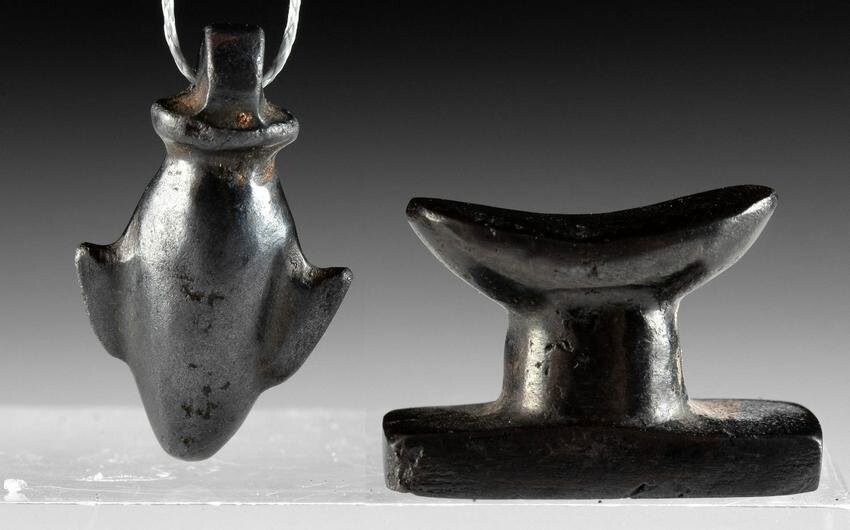Egyptian Hematite Amulets - Heart + Head Rest
**Originally Listed At $800**
Ancient Egypt, Third Intermediate to Late Dynastic Period, 21st to 31st Dynasty, ca. 1070 to 332 BCE. A set of 2 hand-carved hematite amulets, one depicting a petite head rest with a crescent-shaped 'pillow' and a heart-and-windpipe known as "ib." Each petite piece exhibits incredibly smooth surfaces and lustrous graphite-gray hues. Size (head rest): 0.79" W x 0.52" H (2 cm x 1.3 cm); (heart): 0.5" W x 0.81" H (1.3 cm x 2.1 cm)
The Egyptians normally slept on their sides and the curved upper section held the head above the bed. At their most prosaic, the headrests were frequently buried with the mummy providing a place to rest the deceased's head and were found inside the coffin. But also, the importance of having the head elevated was integral with their religious practices as it was intended to aid in resurrection mimicking the sun god rising above the horizon and playing a part in the "Opening of the Mouth" ceremony described in the "Book of the Dead," or the "Book of Going Forth by Day." Near-miniature amulet examples like this were meant as an offering for the deceased to take with them into the afterlife.
According to Carol Andrews, a curator in the Department of Egyptian Antiquities at the British Museum, "To the Egyptians the heart was the most essential of organs, not because it pumped blood around the body - it is unclear that they understood this function - but because they believed it was the seat of intelligence, the originator of all feelings and actions, and the storehouse of memory. This is why it was the heart which was weighed in the balance in the Underworld to ascertain whether its owner was worthy to enter the Egyptian paradise: only it retained the memory of its owner's deeds upon earth." (Andrews, Carol. "Amulets of Ancient Egypt." University of Texas Press, Austin, 1994, p. 72)
Provenance: East Coast collection, New York Gallery, New York City, New York, USA, acquired before 2010
All items legal to buy/sell under U.S. Statute covering cultural patrimony Code 2600, CHAPTER 14, and are guaranteed to be as described or your money back.
A Certificate of Authenticity will accompany all winning bids.
We ship worldwide to most countries and handle all shipping in-house for your convenience.
#175508
Condition Report: Each piece has light abrasions commensurate with age, otherwise intact and excellent. Great surface smoothness and wonderful preservation to overall forms.
View it on
Estimate
Time, Location
Auction House
**Originally Listed At $800**
Ancient Egypt, Third Intermediate to Late Dynastic Period, 21st to 31st Dynasty, ca. 1070 to 332 BCE. A set of 2 hand-carved hematite amulets, one depicting a petite head rest with a crescent-shaped 'pillow' and a heart-and-windpipe known as "ib." Each petite piece exhibits incredibly smooth surfaces and lustrous graphite-gray hues. Size (head rest): 0.79" W x 0.52" H (2 cm x 1.3 cm); (heart): 0.5" W x 0.81" H (1.3 cm x 2.1 cm)
The Egyptians normally slept on their sides and the curved upper section held the head above the bed. At their most prosaic, the headrests were frequently buried with the mummy providing a place to rest the deceased's head and were found inside the coffin. But also, the importance of having the head elevated was integral with their religious practices as it was intended to aid in resurrection mimicking the sun god rising above the horizon and playing a part in the "Opening of the Mouth" ceremony described in the "Book of the Dead," or the "Book of Going Forth by Day." Near-miniature amulet examples like this were meant as an offering for the deceased to take with them into the afterlife.
According to Carol Andrews, a curator in the Department of Egyptian Antiquities at the British Museum, "To the Egyptians the heart was the most essential of organs, not because it pumped blood around the body - it is unclear that they understood this function - but because they believed it was the seat of intelligence, the originator of all feelings and actions, and the storehouse of memory. This is why it was the heart which was weighed in the balance in the Underworld to ascertain whether its owner was worthy to enter the Egyptian paradise: only it retained the memory of its owner's deeds upon earth." (Andrews, Carol. "Amulets of Ancient Egypt." University of Texas Press, Austin, 1994, p. 72)
Provenance: East Coast collection, New York Gallery, New York City, New York, USA, acquired before 2010
All items legal to buy/sell under U.S. Statute covering cultural patrimony Code 2600, CHAPTER 14, and are guaranteed to be as described or your money back.
A Certificate of Authenticity will accompany all winning bids.
We ship worldwide to most countries and handle all shipping in-house for your convenience.
#175508
Condition Report: Each piece has light abrasions commensurate with age, otherwise intact and excellent. Great surface smoothness and wonderful preservation to overall forms.



